Cremators of Manila North Cemetery do their quiet, delicate work
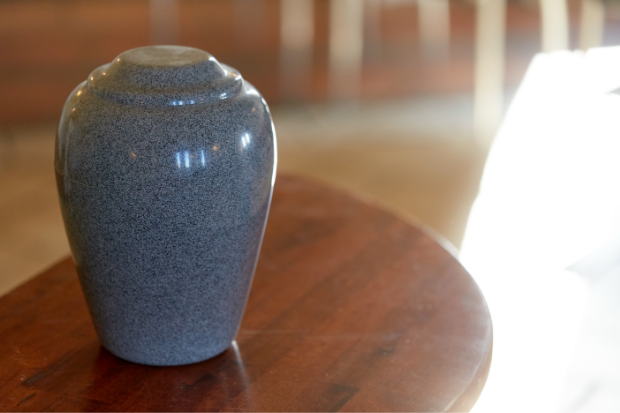
INQUIRER.net stock photo
(Second of two parts)
This man mutters under his breath while working. He asks for forgiveness, addressing the departed as he prepares them for the furnace.
“Pasensya na kayo at kami ay talagang nautusan lang. Kami ang nakalagay dito na mag-operate, mag cremate. Pasensya na kayo sa’min,” he would say to the bodies. “Hindi naman namin kagustuhan ‘yan. Humihingi din kami ng dispensa sa kanila.”
(We ask for your patience because we are just following orders. We have been the ones designated to operate [the machine] and cremate. Please pardon us. We did not want this situation. Please forgive us.)
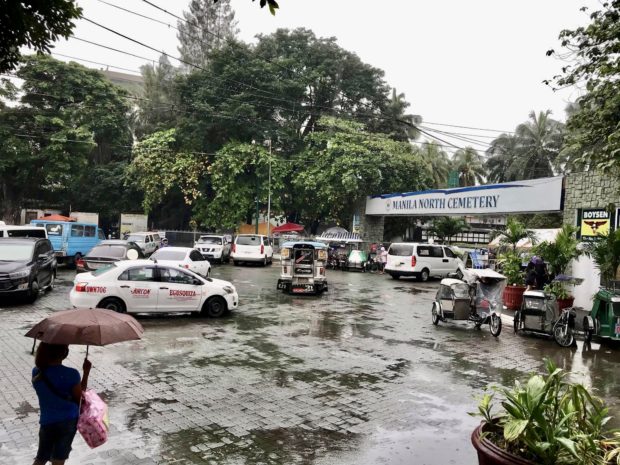
Entrance to Manila North Cemetery this year, without the throng of visitors. INQUIRER.net/Cody Cepeda
Cherry Buenviaje, 51, is a crematorium operator in Manila North Cemetery, where cremation services are free for COVID-related deaths for Manila residents. The crematorium has been closed since July 2019 for renovations, OIC cemetery director Roselle Castañeda told INQUIRER.net, but it had to be opened again last March when COVID-19 struck.
Article continues after this advertisementWhen Buenviaje addresses the deceased, he is really only looking at a cadaver bag.
Article continues after this advertisement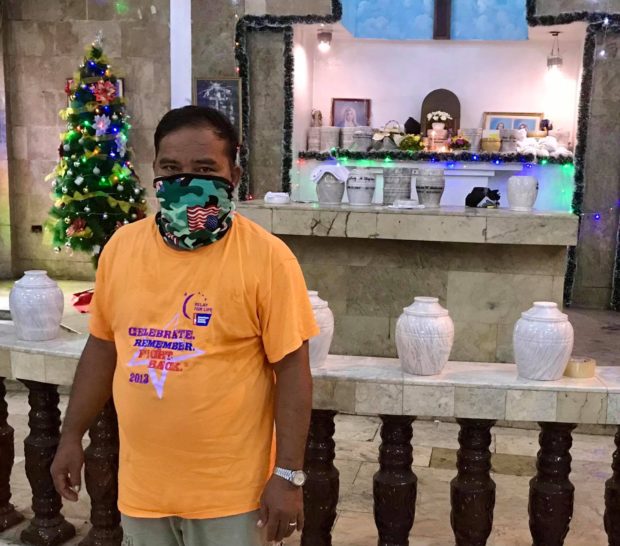
Crematorium worker Cherry Buenviaje. Image: INQUIRER.net/Cody Cepeda
Regardless if the remains of COVID-19 patients are coming from a healthcare facility or a non-healthcare facility such as a home, the remains must be wrapped with a cloth, placed in an airtight cadaver bag and closed tightly with tapes and bandage strips, according to the Department of Health’s Memorandum No. 2020-0158 last March 22. At no instance should the opening of the cadaver bag and removal of the remains be allowed.
The guidelines of DOH in the proper handling of the remains of COVID-19 cases are brief and straightforward. Upon transfer to a funeral home or a crematorium, the procedures for burial or cremation must be done within 12 hours after death.
It seems matter-of-fact on paper, but this small window of time is barely enough for the bereaved families to say their proper goodbyes.
As a crematorium operator while the world deals with the pandemic, it has become a part of Buenviaje’s job to deny grieving families their requests to see their loved ones for the last time.
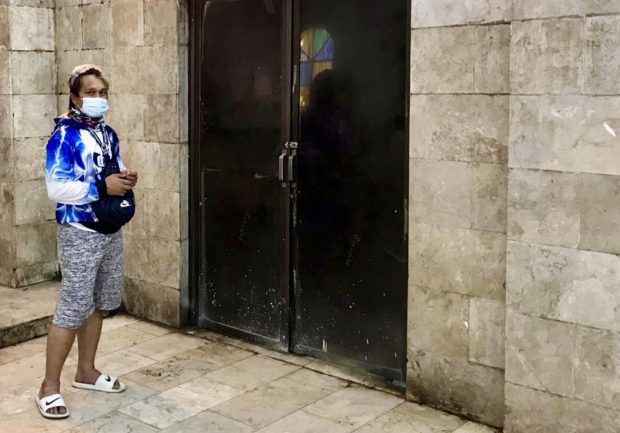
Mark Anthony Regala. Image: INQUIRER.net/Cody Cepeda
This is difficult to navigate for fellow crematorium operator Mark Anthony Regala, 30, who said he also gets requests from families to open the cadaver bags. Painful it may be, Regala firmly denies their wishes.
“Di po namin pinapayagan na talagang buksan ang cadaver bag lalo po pagka COVID po,” he said. “Automatic po talaga pag COVID, hindi po namin binubuksan ang cadaver bag.”
(We really do not allow the opening of the cadaver bag, most especially if it is storing a COVID-19 body. That’s automatic, if it is a COVID-19 case, we do not open the cadaver bag.)
Families are also not allowed to enter the crematorium, he said. When the vehicle arrives with the remains, families are given time to say their farewells while the cadaver bag is still inside. Relatives, however, are no longer allowed to follow when the cadaver bag has been brought to the crematorium.
The process is as impersonal as it is swift. The cadaver bag is immediately placed straight into the furnace where it is left for two hours.
“Ilalapag lang po namin sa carrier tapos itutulak na po namin sa machine namin,” said Regala. (We place it on the carrier then push it towards our machine.)
After the remains are cremated, the workers sift through the bones, grind them, place them in a plastic bag, then seal the bag in an urn.
Regala, who seems to carry a sense of guilt for his job, apologized to the families of those with requests which he had to deny.
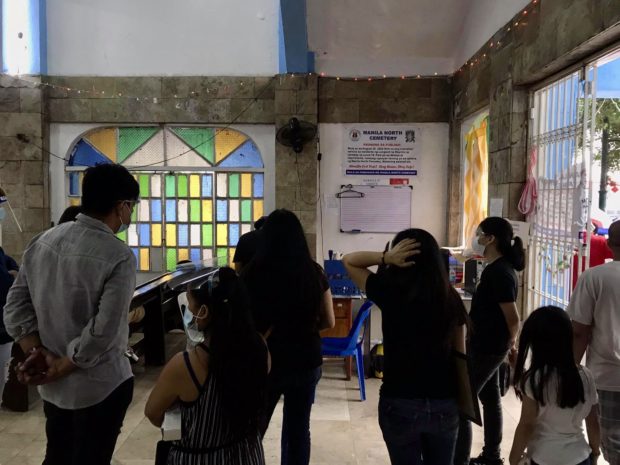
A family waits for the cremation of their relative. INQUIRER.net/Cody Cepeda
“Pasensya na po kayo kung sakaling hindi po namin pinagbigyan ang gusto niyo sa pagbukas ng cadaver bag,” he said. “Isa po sa lahat, kami po ay napag-utusan lang ng aming pamahalaan ng lungsod ng Maynila po.”
(We ask for your forgiveness on instances that we decline your requests to open the cadaver bags. First of all, we have just been ordered to do so by our city government of Manila.)
Buenviaje echoed the same sentiments, saying it is not something they wanted to do but had to.
“Kung kami, hindi namin din kagustuhan ang ganito, kaso ‘yun kako ang naging protocol natin, kaya pasensya na kayo dahil ‘yun din ang utos, na i-cremate. Hindi naman pwede ilibing na ganiyan ang sitwasyon natin,” he said.
(If you ask us, we do not like this either. But this is our protocol. So please understand that that’s the order, to cremate. We cannot do burials under these circumstance.)
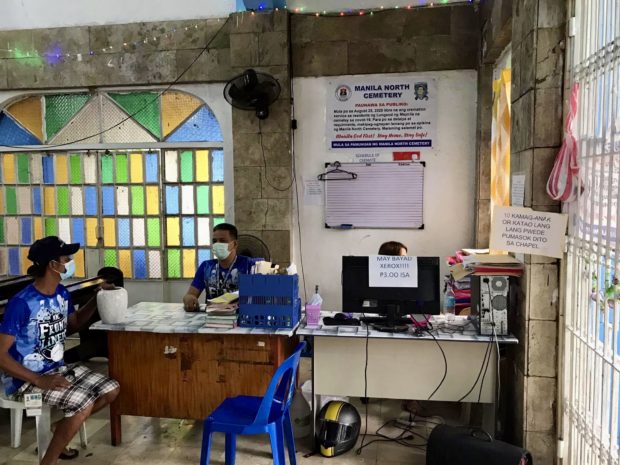
Cremation info desk at Manila North Cemetery. INQUIRER.net/Cody Cepeda
Safety, welfare of crematorium operators
The crematorium operates from 6 a.m. to 8 p.m and only has four operators. The cremations depend on how booked their schedule is for the day, but by 12 noon on a Tuesday, Oct. 20, Buenviaje said they have already had three cremations since 6 a.m.
He admits that he felt a bit nervous about the work at first, back in March, but added that the workers in Manila North Cemetery undergo rapid tests every two weeks care of the Manila Health Department, so they feel some assurance. They are also provided with all the personal protective equipment (PPE) they need by the Manila City Hall, from gloves, masks and PPE suits, as well as alcohol and vitamin C.
“Nasusubaybayan po kung meron sa aming may sakit o wala,” he said. “Sa awa ng Diyos po, andito naman po kami, wala naman nangyari sa’ming masama.”
(We are monitored in case we get sick. By God’s mercy, while we are here, we have not experienced any harm.)
“Bawat salang namin, palit kami ng PPE. ‘Yun kasi ang utos sa amin, na pagkatapos magsalang ng patay, hubarin ‘yung PPE, sunugin na lang para hindi daw kami makapitan ng ano mang uri ng sakit,” he added.
(For every loading, we change PPE. That’s the order on us, that after we load a cadaver, we have to discard the PPE we wore and just burn it, so we would not run the risk of getting any kind of disease.)
Regala, like Buenviaje, recognized the city government’s continued support, which has helped alleviate his own fears about the job.
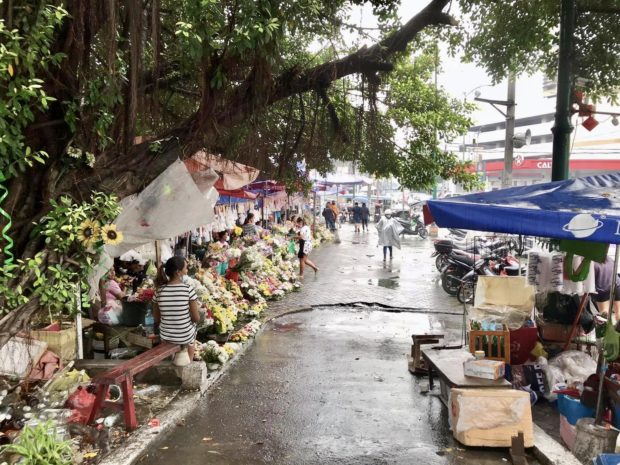
Manila North Cemetery flower vendors. INQUIRER.net/Cody Cepeda
He added, however, that his own family feels wary around him. Regala lives in Bagong Silang, Caloocan City, but because of the pandemic, he has not been able to go home. For now, he sleeps inside the cemetery.
“Medyo lumalayo rin po sila sa ‘kin. Three months po kami na wala pong [gaanong] uwian eh, dahil sa COVID po,” he said.
(They do distance themselves from me. For three months, we hardly went home because of COVID-19.)
Since they are job order workers, Regala added they only earn around P6,000 a month. He recalled that during the height of the pandemic from March to May, they had to cremate a lot of COVID-related remains and rarely had any rest.
“‘Yung tatlo pong [buwan] March, April, May, ‘yun po ang dagsa ng COVID-related namin dito,” he said. “Talagang halos wala na po kaming pahinga ‘nun, na araw-araw po, may i-scheduling po kami ng COVID-related po.”
(March, April and May saw the peak of our COVID-related cases here. We hardly ever rested during those times. Everyday we had schedules for COVID-related deaths.)
Meanwhile Castañeda, OIC director of the cemetery, told INQUIRER.net that communicating openly with the staff and workers may have helped in boosting their morale. She said that she shares with them what she learns from her seminars with doctors from the Manila Health Department.
“Ine-enlighten po kami lahat paano pag-handle, paano ka ma-e-expose, paano ka hindi ma-e-expose, so lahat po ‘yan naririnig ko sa aking mga seminars ini-implement ko po ‘yan dito. Ine-explain ko rin sa kanila,” she said. “So, siguro sa ganun na ‘yung communication namin open, eh wala naman po bumitaw [sa] tao namin at pasalamat po sa Diyos at wala po sa’min na nag-positive.”
(We are all made aware of how to handle the bodies, how we can get exposed to the disease, how not to be exposed; all of those things I learn from the seminars, I implement here and explain to them. So since we communicate openly, no one has withdrawn from the job yet, and by God’s mercy no one of us has been positive.)
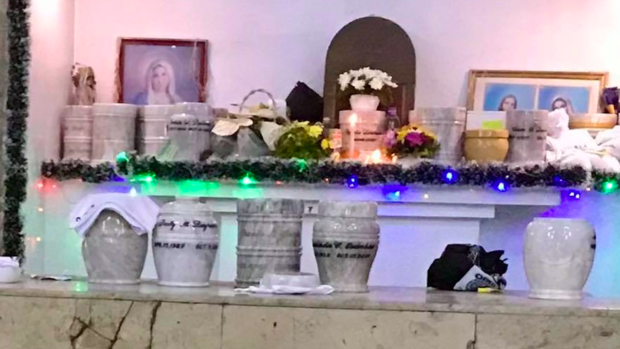
Urns at the Manila North Cemetery crematorium. INQUIRER.net/Cody Cepeda
Fulfilling wishes whenever possible
By the steps outside the Nuestra Señora de Salvacion Chapel, a man with a trolley speaker and a microphone sang Wency Cornejo’s “Hanggang” out of tune.
Upon entering the chapel, one is greeted by the information desk on the right, where the bereaved can inquire and arrange for cremation services for their dearly departed.
Glass urns lined the altar and balustrade in the front. A Christmas tree stood in the far-left corner, while spare Christmas lights hung on the walls.
Family members slowly filed inside the chapel where they were accommodated by the staff. There, they are met with the sharp trivialities that come with death: the inquiries, the handing-over of IDs, cremation permits and death certificates, all the paperwork and the waiting.
As some relatives signed their names on a logbook, a staff approached them and said, “Condolence po.” (Our condolences.)
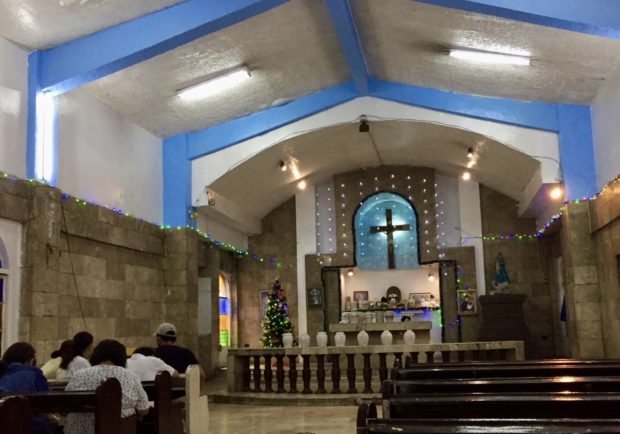
Manila North Cemetery Chapel. INQUIRER.net/Cody Cepeda
It is a reality that staff and workers cannot fulfill the requests of families to see their departed loved ones due to strict guidelines. But when there are little wishes they can find a way to grant, they do so willingly.
Castañeda shared that families sometimes ask if they can have pictures of their loved ones taken while inside the crematorium. Since family members are not allowed to enter, the crematorium operators themselves take pictures from inside, which they give to the families.
Others would ask the crematorium to keep the urns temporarily, so the workers store the urns in vaults for safekeeping. Then there are those who request to have the ashes of their loved ones blessed by a priest, which the crematorium also carries out.
“Meron naman pong pwede magtake ng pictures, ‘yun na lang po ‘yung binibigay namin sa kaanak,” she said. “Sa ganung paraan minsan, at peace na sila. Nakita na nila na naging maayos.”
(We can take the picture for them [if requested], that’s all that we can give the relatives. That way, they are at peace. They are able to see that their departed was taken care of well.) JB
RELATED STORIES:
Manila North Cemetery takes on cremations of city’s COVID-related deaths
No ‘silver bullet’ solution: Tourism workers bear brunt of COVID-19 blow
For more news about the novel coronavirus click here.
What you need to know about Coronavirus.
For more information on COVID-19, call the DOH Hotline: (02) 86517800 local 1149/1150.
The Inquirer Foundation supports our healthcare frontliners and is still accepting cash donations to be deposited at Banco de Oro (BDO) current account #007960018860 or donate through PayMaya using this link.